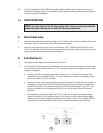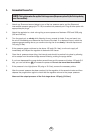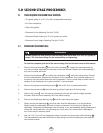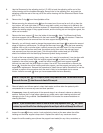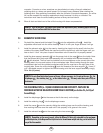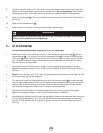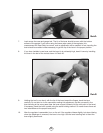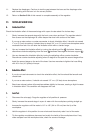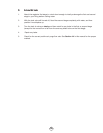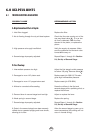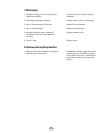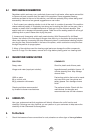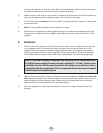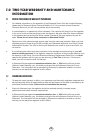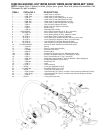
mounting the regulator on the tank valve. Slide the hose protectors back to inspect the areas of
the hose normally covered. Be sure all hose connections are tight.
2. Before turning on the tank air valve, check to make sure that the yoke nut or DIN connection is
tight and the regulator body is aligned properly, with no kinks in the hoses.
3. Turn the tank valve on
slowly and listen for leaks. If any leaks are found, replace or repair parts
as recommended.
4.
Never lift the tank/BCD assembly by the regulator or hoses.
5. Surface-test the regulator by breathing lightly through the mouthpiece. Depressing the purge
button above the water’s surface is
not an appropriate method for testing the function of the
regulator.
B. Post-Dive Care
1. After the dive, blow all water out of the dust cap with clean dry air and place the cap securely
on the regulator inlet. On multiple tank dives, use great care to keep salt water out of the
regulator inlet when tanks are changed. Neglecting these simple procedures is the greatest
cause of corrosion and wear in scuba regulators. When used properly, Sherwood’s exclusive
Dry Air Bleed System keeps all other water-borne contamination out of the first stage body.
2. With the dust cap securely in place, rinse the first and second stages in
clean fresh water. DO
NOT
depress the purge button before or during rinsing since this may introduce water into the
second stage and the low pressure hose. Shake or blow all excess water from the second
stage and allow the entire regulator to air-dry before storing.
3. Store the regulator in a clean bag or storage box, away from sunlight, excessive heat and
humidity.
23
NOTE
: A tiny stream of air bubbles escaping from a small black valve on the first stage indicates that the
Dry Air Bleed System is working. The amount of air used is negligible (13 - 27 cc/min.). Check the system
periodically (see Section 4.3B in this manual), particularly after servicing, to ensure that there is some air
escaping from the black one-way bleed valve. If no air is escaping from the valve when air pressure is applied
to the first stage, have the regulator inspected.



